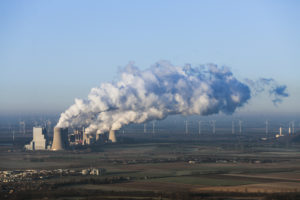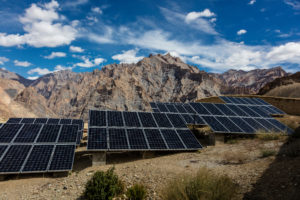As delegates gather in Glasgow for COP26, the 26th edition of the annual UN climate change conference, they are under mounting pressure to deliver an ambitious outcome that addresses the urgent need for rapid, large-scale action on climate change this decade. The conference has been delayed by a year due to the pandemic, but the clock has not stopped ticking on the climate emergency.
Delegates are facing real frustration at a lack of progress on some key issues left over from COP25 in Madrid in 2019. Just prior to Madrid, the UN Environment Programme had stated in their Emissions Gap report that the goal of keeping warming to 1.5C is “slipping out of reach”. Despite this state of urgency, delegates were unable to agree on rules on how countries can reduce their emissions through collaborating with one another. This area is covered by Article 6 of the 2015 Paris Agreement and is the last piece of the Paris Agreement “rulebook” that needs finalising, the rest having been agreed at COP24 in 2018.
Article 6 envisages voluntary bilateral agreements between countries, in the form of development aid. So, for example, developed countries could meet their individual pledges to reduce emissions by providing developing countries with financial support to meet their respective pledges. Such a deal would result in an exchange of credits. The overall aim of the system is not just to reduce carbon emissions but also to raise policy ambition. The detail remains to be resolved, but the article contains three mechanisms:
- Article 6.2 provides a framework linking up different international emissions trading schemes with an accounting system to avoid double counting;
- Article 6.4 envisages a UN body to manage the trade in credits generated by emissions reductions from specific projects, in both the public and private sectors. Its aim would be to promote reductions, while fostering sustainable development and delivering “overall mitigation in global emissions” (OMGE) – in other words to ensure a net increase in ambition, rather than just a shift in emissions reductions from one place to another;
- Article 6.8 provides a non-market mechanism. Currently undefined, this section could be about cooperation on development aid or on climate policy through fiscal measures, such as taxes on carbon usage or emissions.
The issues under discussion are hugely complex. For example, should proceeds from the sale of offsets be set aside during bilateral trading under Article 6.2 or only within the global carbon markets as envisaged in Article 6.4? Should OMGE allow emissions in one place to be offset elsewhere? And should OMGE be applied to both Article 6.4 and Article 6.2? It is unsurprising that agreement on Article 6 should prove so elusive.
Good rules, bad rules
If the delegates have failed to find an agreement so far, it is because they know that Article 6 must set high standards for carbon markets. As the World Resources Institute (WRI) points out: “Without the right rules in place, Article 6 could actually weaken countries’ NDCs (nationally determined contributions) and increase global emissions.” The key principles are that there should be no double counting of credits by parties involved in a particular project; that any emissions reductions that would have happened anyway are excluded; and that increased ambition and progression should be incentivised.
No rules are better than bad rules. But there are still risks if no rules for Article 6 are adopted.Nathan Cogswell, research associate at the World Resources Institute
Nathan Cogswell, research associate at the WRI, told China Dialogue: “No rules are better than bad rules. But there are still risks if no rules for Article 6 are adopted. Having a robust and consistent set of rules is a prerequisite for an Article 6 that supports – not undermines – climate ambition and environmental integrity.”
Tom Evans, researcher at E3G, fears that “weak carbon market rules could slowly erode progress to reduce emissions under the Paris Agreement in the long run. It would also further legitimise low-quality offsetting and corporate greenwashing in the private sector.”
Jennifer Morgan, executive director at Greenpeace, is opposed to carbon offset markets. She says: “Failing to use Article 6 to foster international cooperation and to use it instead to push through global carbon offset markets would be a blow to staying within the 1.5C limit.”
Although Article 6 is widely regarded as the most contentious COP26 agenda item, and all about carbon markets, this view is too narrow, she points out. “There is no reference in the entire Paris Agreement to offsets or markets.” The original purpose of Article 6, she says, was as the place for international cooperation or cooperative approaches. In other words, she says: “How countries can work together and cooperate through a range of measures to equitably support mitigation and adaptation through the delivery of finance, technology transfer, knowledge sharing and capacity building.”
Sticking points
COP26 delegates are facing several sticking points. Evans picks out a few: on double counting of transactions; ensuring some revenues from carbon trading are directed to adaptation efforts; transitioning sustainably from the previous set of carbon trading rules under the Kyoto Protocol (the Paris Agreement’s predecessor); and ensuring carbon trading results in an overall reduction of global emissions.
To make progress, Evans says, “all countries are going to have to be open to compromises – both countries like Brazil and India, which have historically blocked progress on issues like double counting, as well as the likes of the US, Canada and Australia, which typically oppose increasing the revenues from carbon trading that would support adaptation”.
For Morgan, the question is much broader. She calls instead for “a paradigm shift to the negotiations… We cannot pick up where we left off in the climate negotiations in 2019. Since then, the world has experienced a global pandemic, which has highlighted and increased the vulnerabilities of those already most impacted by climate change.”
Positive vision
So, what would be a positive outcome at Glasgow? Evans points to the San Jose Principles, which a group of countries proposed at COP25 in Madrid as the minimum criteria for guaranteeing environmental and social integrity in carbon markets. In essence, the signatories have pledged to avoid double counting of emissions and to preserve the integrity of carbon markets in reducing global emissions. Cogswell cites the vision offered by the ACT2025 consortium, with similar concerns about double counting emissions, the inclusion of Kyoto Protocol credits and ensuring environmental integrity.
Offsets don’t work, they are ineffective and dangerous. They delay climate action.Jennifer Morgan, executive director at Greenpeace
For Morgan, a positive outcome is one that excludes offsets: “Offsets do not prevent emissions from entering the atmosphere and heating our climate. They are an accounting trick to keep emissions off the ledgers of polluters. Moreover, offset projects have led to land-grabbing, biodiversity destruction and human rights abuses. Offsets don’t work, they are ineffective and dangerous. They delay climate action.”
It is a mistake to think that Article 6 will make or break COP26. Evans says: “Article 6 is far from the only important matter to solve at COP26. The main mission at Glasgow is to find a way to accelerate emissions reductions and action to address climate impacts in the 2020s, in order to keep hopes of limiting warming to 1.5C alive. In that context, Glasgow can be a success on many fronts in the absence of an outcome on Article 6.”
Failure to agree on Article 6, Morgan says, does not preclude governments coming to Glasgow with improved NDCs, and with emission reductions in line with the 1.5C target. In other words, she says, “emissions that in aggregate halve global emissions by 2030 and an agreement to do so with a commitment to stop new fossil fuel projects immediately and to put plans forward to phase out fossil fuels by 2050, all while protecting biodiversity and ecosystem integrity.”
Meanwhile, political pressure is being ratcheted up. The UN Environment Programme has once again issued a pre-summit report to encourage the delegates. “Emissions Gap Report 2021: The Heat Is On” shows that the new NDCs, combined with other mitigation pledges, “put the world on track for a global temperature rise of 2.7C by the end of the century, even if all new unconditional commitments are met”.
Climate finance is another contentious issue. Developed nations had committed to provide US$100 billion a year by 2020, but an OECD report last year estimated that in 2018 only some US$79 billion per year had been paid out. This year, the developing nations raised the price of their cooperation. At a July global climate meeting in London, the South African environment minister, Barbara Creecy, said US$750 billion per year was needed.
Funding for climate change projects is clearly important, but raising the stakes like this may prove counterproductive to achieving a deal on a post-2025 finance arrangement. Morgan warns: “For countries demanding climate funding, I think US$750 billion may be a gamble, considering this is an existential threat for them.” For Morgan, the next steps are clear: “Developed countries need to deliver the US$100 billion they promised. And more needs to be delivered on top of that for adaptation and to address the losses and damages already incurred from current global heating. We need all parties to be part of the solution.”








